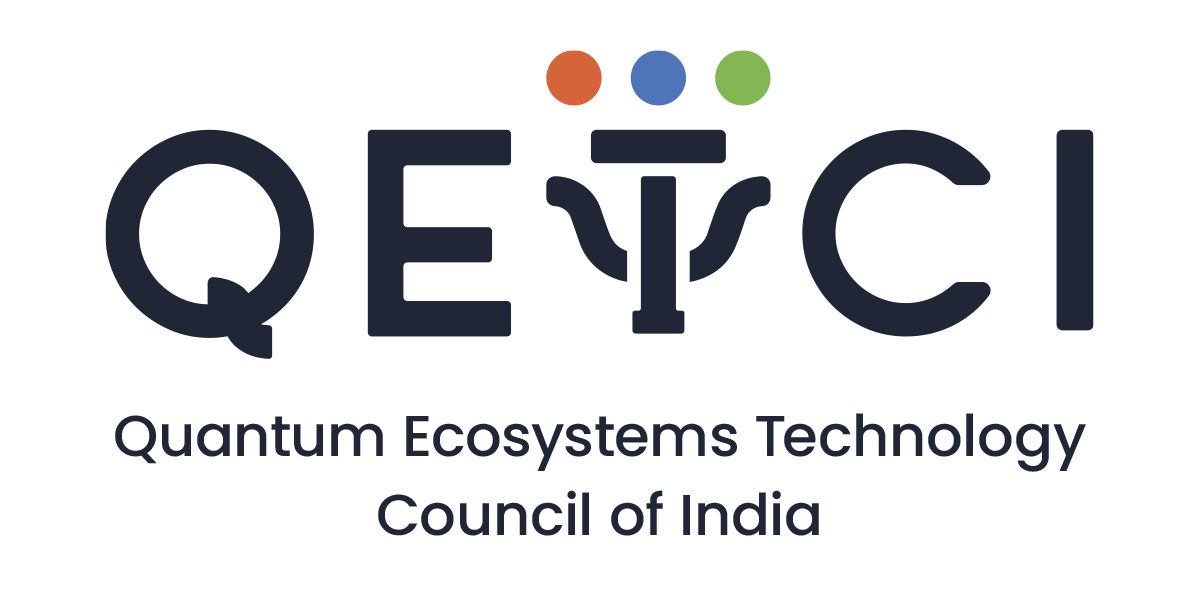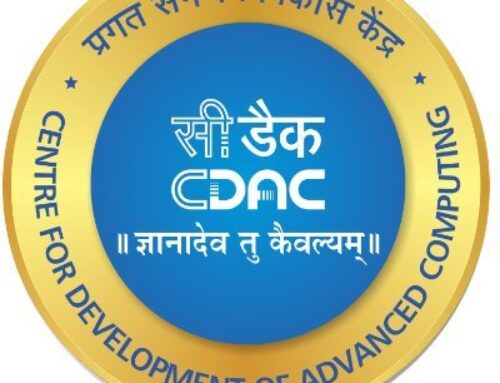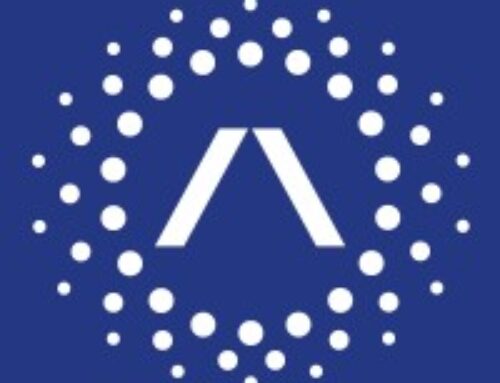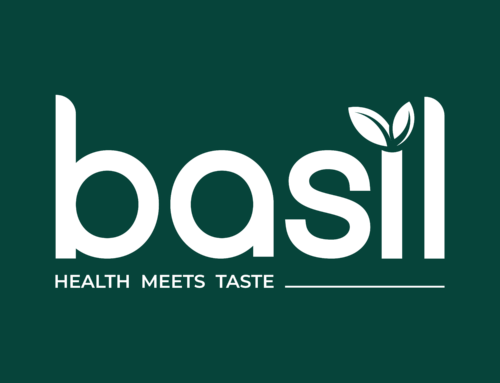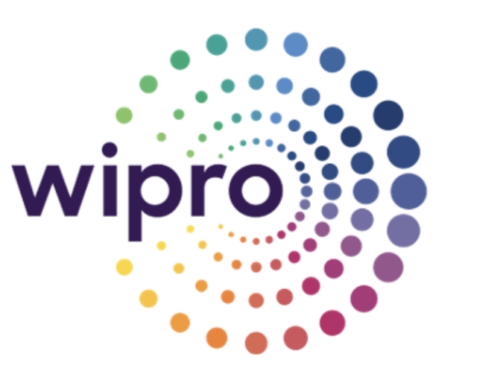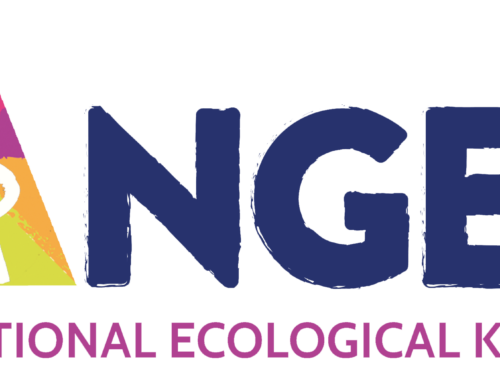QETCI has published the Quantum Value Chain Report 2023 – India, which introduces a Quantum Value Chain Framework for analyzing the state of the quantum ecosystem in India.
Defining the Value Chain
Originally proposed by Michael Porter for individual firms, value chain analysis is an important tool that examines an organization’s activities that collectively contribute to the creation, production, and delivery of products or services (1). It enables insight into which activities create the most value and which ones may be outsourced. The concept has since been extended to study national and international production networks (2).
Within this context, a specific industry can be viewed as the movement of value among entities in its ecosystem. The value chain now encompasses all vertical stages, from raw material providers to end-users, as well as entities that inhabit the horizontal layers, such as educators and government bodies. Mapping these elements reveals the roles, functions, and interconnections of the entities, thereby helping policymakers, researchers, and businesses make effective decisions.
Why Value Chain Analysis?
Conducting a value chain analysis enables a deeper understanding of industry dynamics, identifies weak links, and highlights areas for potential improvement. In the context of the quantum technology industry in India, such an analysis is vital for recognizing gaps, finding growth opportunities, and addressing both technical and non-technical challenges. Understanding the country’s quantum technology value chain also supports policy formulation, which is crucial in the early stages of any emerging technology.
An alternative approach—supply chain analysis—is more limited and does not account for all the factors contributing to an ecosystem. In contrast, the value chain can be seen as a supply chain enhanced with ecosystem dependencies and external interfaces.
The Quantum Value Chain Framework
The Quantum Value Chain Framework is a mapping of the various elements in the quantum ecosystem. It was created to provide a thorough understanding of:
- How value flows within the country’s quantum ecosystem
- The roles played by direct and indirect actors
- The dynamics of value creation
Key motivating questions include:
- How do we map the quantum ecosystem for a country, state, or region so that we can take the necessary steps to accelerate it?
- Why is a traditional supply chain representation insufficient for a nascent and evolving technology ecosystem?
- How do we identify dependencies between different aspects of the ecosystem so that policy decisions address all gap areas?
- How can we ensure our insights are based on data and evidence?
This framework was developed and analysed after careful primary surveys and secondary research. Below are the key stakeholders identified as elements in the Indian quantum technology value chain:
| Entity | Definition |
| Education Provider | An entity that creates and/or delivers educational content on quantum technology and associated domains. |
| Researcher | An ecosystem entity that is engaged in research associated with quantum technology |
| Regulatory Body | A national entity that is responsible for creating, enforcing, and overseeing regulations and rules within the quantum ecosystem |
| System Integrator | An ecosystem entity that, without hardware capabilities of its own, provides base software and/or algorithms and/or solutions to the end user |
| Integrated System Provider | An ecosystem entity that may or may not develop indigenous quantum hardware, and provides it along with base software and algorithms to quantum solutions providers |
| Enabling Technology Provider | An non-quantum ecosystem entity that plays the role of providing technology that assists and enables the development of quantum technology (hardware). |
| Hardware Provider | An ecosystem entity that is engaged in the development of the hardware of quantum devices, like quantum computers, QKD devices, and quantum sensors |
| Base Software Provider | An ecosystem entity that develops firmware and control protocols for the underlying quantum hardware |
| Algorithms Provider | An ecosystem entity that works on quantum communication protocols, PQC schemes, or quantum computing algorithms for specific applications |
| Solutions Provider | An ecosystem entity that provides solutions by way of software products or consulting services to end-users interested in specific applications of quantum technology |
| Standards Body | An ecosystem entity that is responsible for the development of standards and regulatory recommendations associated with quantum technologies |
| Investor and Incubator | An ecosystem entity that provides financial support, mentorship, resources, and networking opportunities to quantum technology projects |
| Enabling Government Entity | An government entity that oversees and assists the development of quantum technology at various layers of the value chain |
| Ecosystem Enabler | An ecosystem entity that works closely with different stakeholders to enhance collaborations, mitigate challenges, and accelerate the ecosystem as a whole |
| End user | An ecosystem entity that is interested in the applications of quantum technology |
| Allied value Chains | Value Chains from allied industries which add value to the Quantum Value Chain. |
The Indian Quantum Technology Value Chain
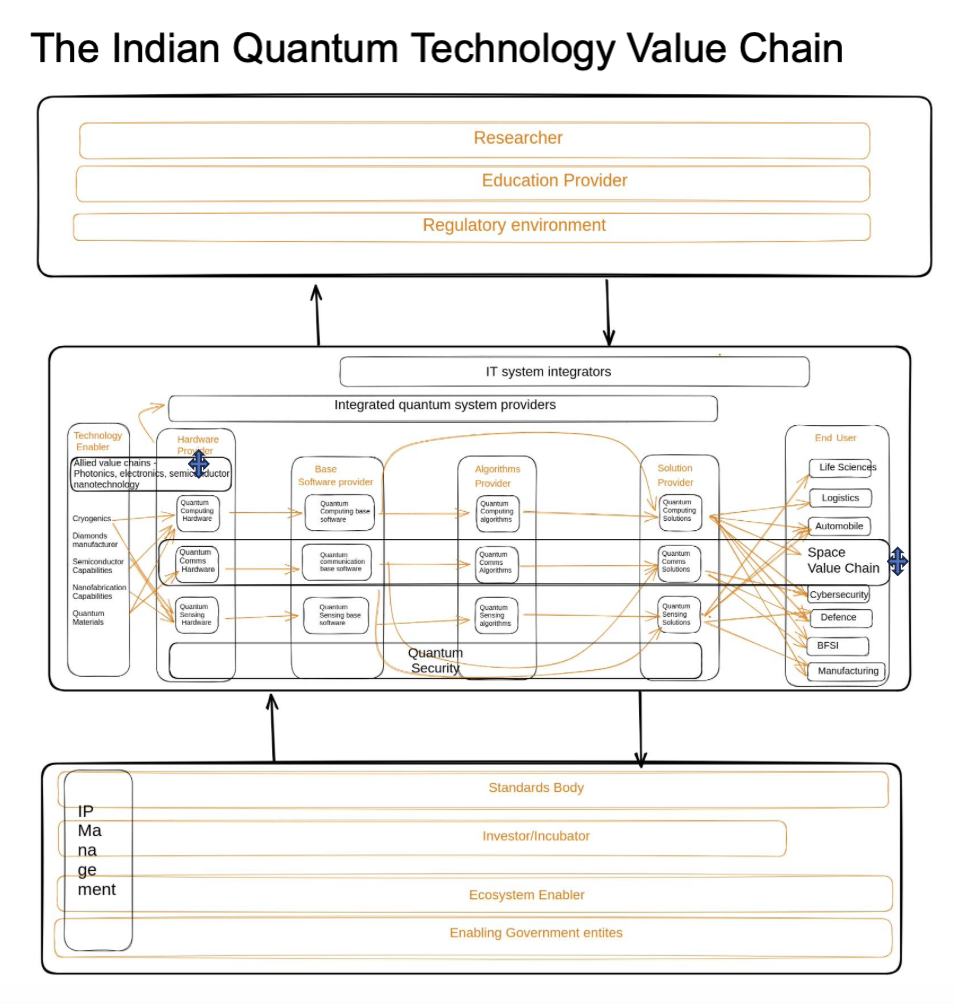
Fig1 : The Quantum Value Chain
The figure above illustrates the Quantum Value Chain in detail. It can be studied in two parts:
- The Supply Chain: The central box in the representation includes elements of the supply chain.
- The Horizontal Layers and Additional Elements: These layers provide an overview of the broader value chain, encompassing non–supply chain ecosystem elements. Together, they describe how value flows within the ecosystem and identify entities that deliver value across it (e.g., standards bodies or ecosystem enablers like QETCI).
A third component represents an Allied Value Chain—i.e., industries that are closely related and can further strengthen quantum developments.
Evaluating Relative Strengths
The relative strengths of various elements within a national value chain can be evaluated by analyzing interview data and secondary research. These results are applied to the Value Chain Diagram via color coding:
- Dark Green – Established
- Light Green – Advanced
- Orange – Building Up
- Yellow – Early Efforts
- Red – No Presence
The report provides this color coding for India, with each value chain element defined in detail.
Example:
Enabling Technology Provider
This category includes entities working on technologies critical for the development of quantum hardware. Examples include various specialized components used in quantum computers, sensors, and communication devices.
Key Aspects of This Innovative Framework
- Unique Value Chain Framework: Enables self-assessment for an ecosystem (state, country, or region).
- Customizable: Although developed for quantum, it can be adapted to other emerging and evolving technology areas.
- Supports Systems Thinking: Allows for holistic ecosystem modeling, enabling experiments within the ecosystem and providing evidence-based insights for policymaking.
- Identifies Levers: The systems approach highlights factors that can accelerate the quantum ecosystem in a given state, country, or region.
- Standardization Potential: The self-assessment framework can become a standardized mechanism for comparing quantum ecosystems—and, eventually, other emerging technology ecosystems.
- Global Uniqueness: There is no other comprehensive framework of this nature globally. This was confirmed before positioning and publishing the framework.
- Uncovering Valuable Players: Applying the Value Chain framework to the Indian quantum ecosystem also helped identify valuable players from allied markets that propel research, development, and entrepreneurship.
According to Mr S. Krishnan (Secretary, MeitY), “The report sets the groundwork for advancing quantum technologies within the country. Additionally, there is a need for collaborative efforts among the government, industry, and academia to prepare the nation for global competitiveness.”
Adoption and Recognition
-
- Recommended Best Practice: The World Economic Forum’s Quantum Economy Blueprint endorses this framework as a best practice for setting up quantum ecosystems.
- Netherlands–India Project: The framework forms the basis of “Unveiling the Indo-Dutch Quantum Frontier: A Transformative Exploration of its Techno-Economical and Societal Impact,” a funded project set to be launched in January 2025.
- Australia–India Project: Another funded project, “Foundational Principles for Responsible Development and Use of Quantum Technologies in the Indo-Pacific Region,” will leverage the Quantum Value Chain Framework and Report.
- UAE 2030 Program: Reena Dayal ( inventor of the Value Chain Framework) has been added to the Innovation Council for Quantum for the UAE’s 2030 Program, which will also utilize the Value Chain Framework.
- Telangana Quantum Plans : The Quantum Value Chain was used to map the state of the quantum ecosystem in Telangana and is now being used for preparing detailed plans
(1) Porter, M. E. (1985). Competitive Advantage: Creating and Sustaining Superior Performance.
(2) Quantum Value Chain Report by QETCI


